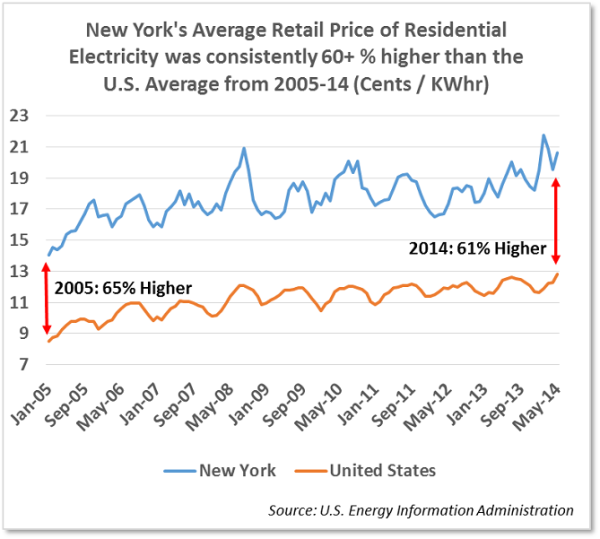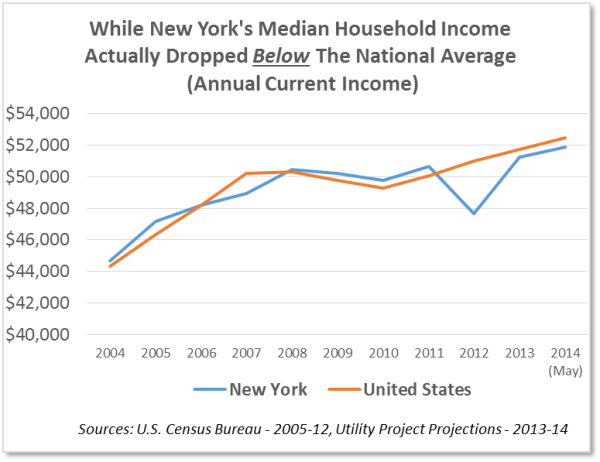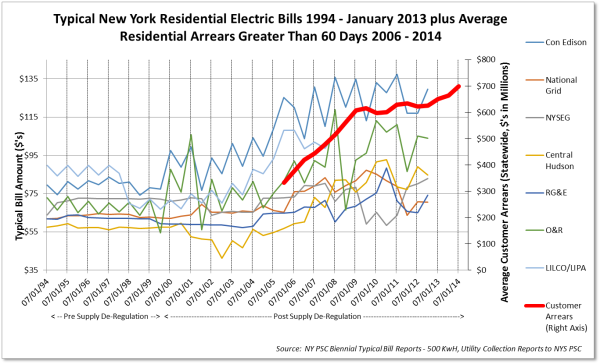AARP and Utility Project Reply Comments Highlight Customer Protection, Affordability In NY PSC Revised Energy Vision “REV” Case
AARP and Utility Project Reply Comments filed October 24, 2014 respond to initial comments of other parties on the New York Department of Public Service (DPS) Staff ‘s Track 1 Straw Proposal for “Developing the REV Market” in the New York PSC “Reforming the Energy Vision” or “REV” proceeding. The REV proceeding is a generic inquiry concerning future direction and structure of the electric industry in New York State, and the PSC is considering changes to the regime it implemented under its 1996 “Vision Order” (and follow-on orders) that spawned non regulation of the power generation function and the advent of ESCO providers of retail energy services. Under that Vision, New York electric rate are among the nation’s highest.. According to the Commission, under REV, which the PSC intends to finalize in early 2015:
“This initiative will lead to regulatory changes that promote more efficient use of energy, deeper penetration of renewable energy resources such as wind and solar, wider deployment of “distributed” energy resources, such as micro grids, on-site power supplies, and storage. It will also promote greater use of advanced energy management products to enhance demand elasticity and efficiencies. These changes, in turn, will empower customers by allowing them more choice in how they manage and consume electric energy. The Commission has identified six core policy outcomes relating to customer knowledge, market animation, system-wide efficiency, fuels and resource diversity, system reliability and resiliency, and carbon reduction.”
The PSC has indicated an interest in opening the utility distribution system and services to new third party “DER” providers, which seem to be rather similar to the original deregulatory concept of ESCOs as described in the 1996 “Vision Order.” Under the ESCO system, most ESCO customers pay more for the same service the utility provides, customers lost consumer protections until some of them were restored by the legislature, and there are many consumer complaints against ESCOs for fraud, deception, slamming, and overcharging. Currently there are 282 listed active parties in the REV proceeding, many of whom filed comments in response to Commission questions earlier this year. Several consumer groups also filed a joint letter raising their concerns about the REV proposal, which would allow for more deregulation of distribution utility functions. Concerns over the process and pace of the proceeding as well as customer protection and affordability under a REV regime are raised in the AARP and Utility Project response to a set of PSC questions which preceded the Staff effort to develop its Straw Proposal. In September, along with many other parties, AARP and the Utility Project filed initial comments on the Staff Track 1 Straw Proposal, again raising concerns about the costs of the REV initiatives, customer protections and affordablility which were not addressed in the Straw Proposal. See AARP AND UTILITY PROJECT FILE COMMENTS ON NY PSC STAFF TRACK I “STRAW PROPOSAL” IN “REV” PROCEEDING, September 22, 2014. AARP New York and the Utility Project noted in their October 24 Reply comments that the PSC staff’s August 22, 2014 REV track 1 Straw Proposal did not address issues and concerns raised in the parties’ initial comments. Instead, it focused primarily on broad policy direction without cost benefit analysis, and DER market recommendations that conflict with or fail to recognize the essential ratepayer concerns and recommendations regarding cost effectiveness, price, and consumer protection. The AARP and the Utility Project Reply Comments note various entities submitting initial comments supporting REV are primarily interested in promoting specific initiatives and programs that they see as vital to their own business interests. Each of the proposed initiatives and programs will have a significant impact on the affordability of essential electric service, a focus that does not appear to have been the basis for many of these other organizations’ recommendations. The utilities’ joint reply comments point out, as do the consumer groups, that the utilities are the only party with the legal duty to assure that all service is adequate and provided at just and reasonable rates, terms and conditions of service. Notably missing from the Staff Straw Proposal, as well as from the initial comments of other parties, is any emphasis on the Draft State Energy Plan discussion of the affordability of energy services for New York’s low-income households. The first recommendation of the 2014 draft State Energy Plan is that New York’s implementation will focus on “improving energy affordability.” The draft plan lists as key points improvement of energy efficiency programs for low income consumers, and recommends that the following metrics be tracked to ensure the improvement in energy affordability:
• Keep New York residential customer electric bills as a percentage of household income at or below the national average (% of median household income)
• Reduce the percentage of household income devoted to energy bills for low-income New Yorkers (% of low to moderate household income)
• Improve competitiveness of industrial customer electric rates—maintain below national average
• Decrease number of customers relying on oil or propane for heat
• Increase energy efficiency resource deployment (MW, MWh, DTH, $/resource)
• Decrease electric system peak demand (MW)
• Improve utilization of existing electric infrastructure—increase load factor (average load compared to peak load) (MW capacity and the total GWh energy requirement [i.e. “sendout”]).
These recommendations and concerns about energy affordability are reflected in volume II of the draft State Energy Plan, and its appendix covers concerns about the potential negative impact of changes to time of use “smart meters”, and therefore to pricing, on low-income households. Other groups have proposed expensive mass deployment of such meters to enable synchronizing prices with unreliably spiking prices in the NYISO wholesale spot markets, even though very few customers choose time of use pricing. The draft State Energy Plan documents the stark reality of New York’s high energy prices and their impact on household income, as well as the lack of robust bill payment assistance programs:
“New York’s households with incomes below 50 percent of the Federal Poverty Level pay more than 40 percent of their annual income for home energy, whereas households above 150 percent of the Federal Poverty Level pay more than 6 percent.”
A footnote accompanying these statements notes that New York ranks second in the nation in terms of residential cost (after Hawaii), and that the State’s electric cost—at 18.26 cents per kWh—is much higher than the national average—11.58 cents per kWh—citing data from the Energy Information Administration, which is more graphically presented in the following chart that is derived from the EIA data:
What makes this price disparity even more disturbing is that New York’s median household income level has dropped below the national average:
The affordability problem is mentioned in Volume II of the 2014 Draft Energy Plan:
“Since 1998, home energy costs have increased 33 percent for very low-income households, far outstripping any increase in income. Families eligible for federal home energy assistance spend one-fifth of their income on home energy bills – six times more than the level other income groups spend. “Very low-income households are often forced to make desperate tradeoffs between heat or electricity and other basic necessities. Research has found that 47 percent of households that received federal home energy assistance over a five-year period went without medical care, 25 percent failed to fully pay their rent or mortgage, and 20 percent went without food for at least one day as a result of home energy costs. These numbers starkly illustrate the vulnerability of these households to acute and gradual rises in the direct and indirect costs of energy, especially within the context of the relative energy inefficiency of their homes. “Because the cost of energy has a regressive impact on lower income households, special care must be taken to protect these households from any direct and indirect negative impacts caused by spiking energy prices. Currently, in New York, lower income households receive bill credits to offset the costs of energy. The amount of credits available to lower income households vary from utility to utility. The variation often depends on the inclination of the utility and how the issue is approached in PSC rate cases. Establishing a more substantial bill discount, such as California’s 20 percent, uniformly throughout the State would help protect lower income households from the economic burden of energy prices.”
Furthermore, the Commission’s own reported data on residential customer bills and arrears in excess of 60 days dramatically shows that bills have been volatile, and that arrears that are 60+ days old are growing at a dramatic pace:
Utilities express concern over REV Cost implications of REV, customer privacy policies, cost effectiveness, and the need for a complex integration of the many implementation processes that would be required by the Staff’s Straw Proposal, are also raised by the Joint Utilities in their Reply Comments, The Joint Utilities agree with numerous comments relating to the potential adverse net impact of REV implementation on customer bills, stating:
“The implementation of REV must take into account this impact for all customers, including both REV participants and non-participants, with particular attention paid to low- and moderate-income The implementation of REV must take into account this impact for all customers, including both REV participants and non-participants, with particular attention paid to low- and moderate-income customers.”
New York City Expresses Concern New York City also weighed in with a range of concerns over both the process and impact of the Commission’s REV proceeding. New York City’s Reply Comments it noted that:
[a] continued focus on just and reasonable rates must be included, as well as preservation of a safe, reliable, and resilient electric system. Moreover, the system and the regulatory framework should ensure that all customers, regardless of economic status, receive adequate service; In general, the level of electric service received should not depend on what a customer can afford to pay. Similarly, Con Edison has historically had one of the most reliable electric systems in the world, and that system was achieved via the rates paid by customers. Going forward, the reliability of the electric system must be maintained, and customers should not be required to pay more to receive the same high level of service…. While it is possible that the REV will result in electric bill reductions, … the Staff White Paper offers no facts or other basis to support this claimed benefit.… [T]he Commission should require further information before simply accepting this statement…. [C]ustomers should not be required to fund competitors in order to allow them to compete. If competitors cannot offer their products and services at competitive prices, they should not remain in business, and customers should not be required to underwrite or otherwise support unsustainable businesses.
Process Concerns The delay in the publication of a Staff Proposal for Track 2 issues without any date established for how they will be implemented heighten concerns about the lack of integration between policy proposals in Track 1 and implementation of them in Track 2. There is no assurance the policy proposals will be cost effective and will not not burden New York’s already stressed customers with even higher costs. This is a distinct possibility because DER proposals may favor groups of customers to the detriment of others– for example those whose subsidized solar generation and net metering may shift large costs and raise bills to other customers. Unlike California, which has spearheaded local solar generation now being promoted for New York, New York lacks the protection California gives to its low-income customers through its robust low-income rate programs. Also, unlike California, New York lacks a strong statutory intervenor compensation program to assure well resourced and independent customer group participation in major regulatory proceedings, as a New York Moreland Commission recommended. Conclusion The AARP and the Utility Project Reply Comments urge the Commission to make energy affordability for New York consumers a primary focus of the REV proceeding. There are a wide variety of potential programs and policies that could be properly designed, whether through Track 1 or Track 2, which would focus on energy affordability, in particular the recommendations associated with energy affordability as set forth in the draft State Energy Plan, but these have thus far been virtually ignored in the REV proceeding. This is a defect that the PSC should promptly and conspicuously remedy.
Gerald A. Norlander
Follow New York’s Utility Project on Twitter



